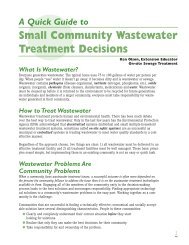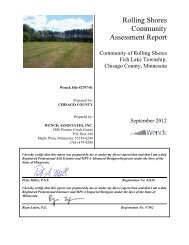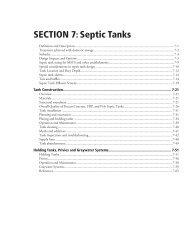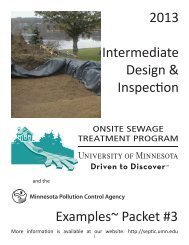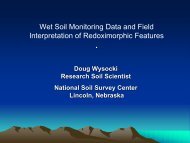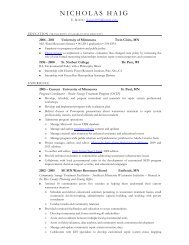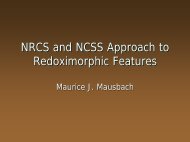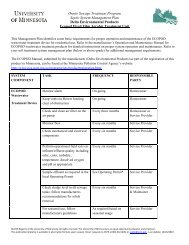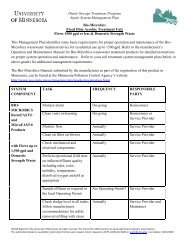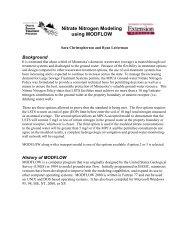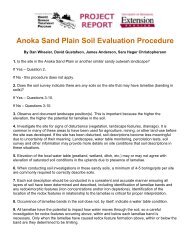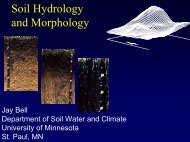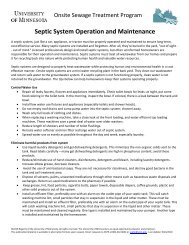MPCA Design Guidance for Large Subsurface Wastewater ...
MPCA Design Guidance for Large Subsurface Wastewater ...
MPCA Design Guidance for Large Subsurface Wastewater ...
You also want an ePaper? Increase the reach of your titles
YUMPU automatically turns print PDFs into web optimized ePapers that Google loves.
• ground-water mounding<br />
• vadose zone mounding (over soil restrictive layers)<br />
• nitrogen dilution<br />
• phosphorus attenuation<br />
If during the preliminary site evaluation one or more of these concerns appears to be significant, it is<br />
recommended that either an alternative LSTS site be selected or that the detailed soils/hydrogeologic<br />
evaluation focus initially on the concern representing the greatest risk.<br />
4. Soils evaluation / treatment (complete Attachments 4A and 4B)<br />
Generally, the soils evaluation is conducted to a depth of no greater than seven feet. The soils evaluation<br />
depth is usually equal to the distance to the bottom of the proposed soil dispersal system (maximum of<br />
four feet) plus the necessary soil treatment zone thickness (generally considered to be three feet). The<br />
purpose of the soil evaluation is to:<br />
• Determine the presence of any soil characteristics that may impact the suitability and/or<br />
thickness of the soil treatment zone (seasonally saturated soil, bedrock, extremely coarse soil<br />
textures, etc.). The thickness of the necessary unsaturated treatment zone below the soil<br />
dispersal system will be measured from these features or from any ground-water mound which<br />
may <strong>for</strong>m above these features.<br />
• Determine the infiltration rate from the soil dispersal media into the surrounding soil<br />
(infiltration/loading rate).<br />
• Determine the presence and possible influence of any other soil characteristics that may<br />
influence the soil sizing factor, hydraulics and/or constructability (hard pans, abrupt textural<br />
changes, disturbed soil, smearing, compaction, etc.).<br />
• Determine the treatment abilities of the unsaturated soil based on soil texture, depth of<br />
unsaturated zone, and loading rate.<br />
• Determine any construction-related concerns (slope, topography, smearing, compaction, etc.).<br />
State law requires evaluation of the soil be per<strong>for</strong>med by a licensed subsurface treatment system (SSTS)<br />
designer who works with or is a professional soil scientist (PSS) licensed in Minnesota.<br />
The first step in a soils evaluation involves reviewing the applicable county soil survey in<strong>for</strong>mation, if<br />
available. This can be accomplished online at http://websoilsurvey.nrcs.usda.gov/app/.<br />
The second step is to determine site restrictions and unusable areas, such as easements, setbacks,<br />
unsuitable topography and disturbed areas.<br />
The third step involves choosing the location and examination of the soil in soil pits. Soil observations<br />
and descriptions must be in accordance with the U.S. Department of Agriculture’s Field Book <strong>for</strong><br />
Describing and Sampling Soils found at (http://extension.agron.iastate.edu/soils/SSDS_maps.html). Soil<br />
descriptions must be recorded on soil log reports in Attachment 4A of this document or similar <strong>for</strong>mat.<br />
Test pits should be evaluated to a depth equal or greater than the proposed soil dispersal depth<br />
(maximum of four feet) plus the thickness of the treatment zone (generally three feet unless a pathogen<br />
pretreatment method is proposed). Enter soil pits in accordance with Occupational Safety and Health<br />
Administration (OSHA) confined space requirements. Enough test pits should be excavated and<br />
analyzed to adequately characterize the site. One test pit per 10,000 square feet of dispersal area is<br />
recommended. Test pits must be located within or near the system boundaries. It is important to locate<br />
test pits such that the disturbed soil will not interfere with the future absorption area.<br />
The soil morphology in<strong>for</strong>mation gathered in the test pits is to be used to size the needed absorption<br />
area. Conventional sizing values are recommended as a starting point, but may need to be changed based<br />
on other loading considerations, such as ground-water mounding, waste strength loading or nitrogen<br />
loading. Conventional loading rates are found in Attachment 4B.<br />
<strong>Design</strong> <strong>Guidance</strong> <strong>for</strong> <strong>Large</strong> <strong>Subsurface</strong><br />
Minnesota Pollution Control Agency<br />
<strong>Wastewater</strong> Treatment Systems April 2010<br />
9



